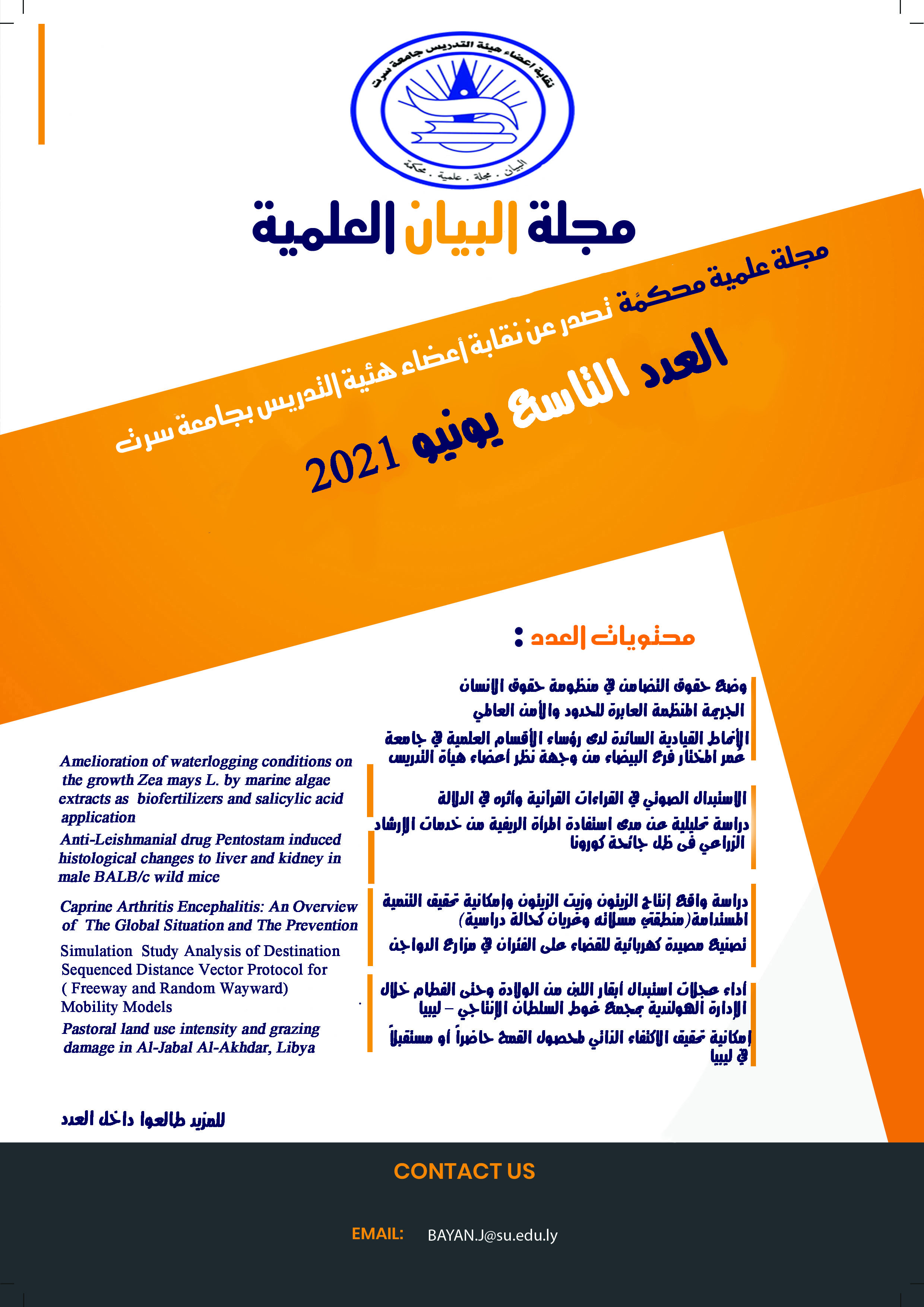Pastoral land use intensity and grazing damage in Al-Jabal Al-Akhdar, Libya
الكلمات المفتاحية:
land use intensity,، grazing damage,، Libyan Al-jabalAlakhdar region.الملخص
الرعي في نطاق مفتوح عبارة عن إجهاد تقليدي للأراضي الرعوية بمنطقة الجبل الأخضر من ليبيا والى الأن لم يتم تقييمه بشكل منهجي منظم على مستوى المنطقة. تم إنتاج خريطة غطاء أرضي بمساحة 90.000 هكتار بواسطة الاستشعار عن بعد ونظام المعلومات الجغرافية ثم التحقق الميداني لدقة الخريطة وذلك لغرض تصنيف الغطاء الأرضي وكذلك أيضا تقسيم المنطقة إلى وحدات لحساب عدد الحيوانات داخل كل وحدة وقدرتها الاستيعابية. تم تقدير معدل التخزين الفعلي (ASR) بحساب عدد الماشية , مع مراعاة اختلاف أعداد الماشية جغرافيًا من منطقة إلى أخرى داخل الإقليم ، لذلك تم حساب ASR بطريقة أكثر دقة تعتمد التوزيع الجغرافي المكاني عن طريق تقسيم المنطقة باستخدام شبكة نقطية إلى 217 وحدة رعوية ومقارنة العدد الكلي بالسجلات الحكومية. كذلك أيضاً قدرت كمية الأعلاف المضافة والتي تبلغ حوالي 50 كجم/ 100هكتا ر/ يوم خلال فترة ثلاثة أشهر في السنة وتم إدراجها من ضمن حسابات معدل التخزين الفعلي . اعتمدت هذه الدراسة في حساب معدل التخزين المستدام (SSR) على كمية الكتلة الحيوية السنوية المطلوبة لكل حيوان (R) ، نسبة تغطية سطح التربة بأنواع نباتية سنوية وشجيرات صالحة للأكل (F) ، ومتوسط الكتلة الحيوية المستساغة بعد موسم الجفاف (P) ، و X وهو متغير يأخذ في الاعتبار كفاءة الرعي اعتمادا على أن الحيوانات لا تأكل 100٪ من النباتات . طبقت هذه الدراسة بثلاثة سيناريوهات مختلفة لتقييم العامل, X الاقتراح الأول وهو مجموع الكتلة الحيوية الصالحة للأكل مضروبة في 0.5. الاقتراح الثاني وهو X = 0.5 للعشب السنوي و X = 1 للشجيرات, الاقتراح الثالث X = 0.5 للعشب السنوي وحساب معدل الاستساغة للشجيرات. وخلصت هذه السيناريوهات إلى أن الاقتراح الثالث كان الأفضل بمعدل ارتباط 0.92 مع مؤشر الضرر البيئي الناتج عن الرعي.
ساهمت هذه الدراسة في إضافة جديدة لم تتم تجربتها من قبل في حساب ASR و SSR. وكذلك تحصلنا على علاقة عكسية بين معدل إنتاج الكتلة الحيوية لكل من العشب و الشجيرات وكانت الكتلة الحيوية الكلية ثابتة تقريبًا عند حوالي 815 كجم \هكتار.
المراجع
References:
Abdalrahman, Y., Bzeou, A., & Mohamed, A. (2017). ‘Index of degradation evaluation for pastures lands in Al-Jabal Al-Akhdar region. The fifth Scientific Conference of Environment and Sustainable Development in the Arid and Semi- Arid Regions (ICESD). Ajdabiya, Libya, Ajdabiya University (pp.544-552).
Ahtash, A. E., Biala, A. S., Magid, A. F. & Marhoun, H. M. (2010). Carcass Characteristics of the Libyan Purebred Mahali Goat and their Crosses with Damascus and Morcia Granada Goats. Agricultural and Marine Sciences, 15, 21-27.
Akraim, F., Milad, S., Abdulkarim, A. & Ganem, M. (2008). Wool characteristics of Libyan Barbary sheep in north-eastern Libya: fiber diameter and staple length. Livestock Research for Rural Development, 20(8), 11-19.
Animut, G. & Goetsch, A. L. (2008). Co-grazing of sheep and goats; benefits and constraints. Small ruminant research, 77, 127-145.
Agricultural ministry. (2017). Agricultural Development Achievements Report No.18. El Bayda, Libya: Ministry of Agriculture.
Catchpole, W. R., & Wheeler, C. J. (1992). ‘Estimating plant biomass: A review of techniques’. Australian Journal of Ecology, 17, 121-131.
Congalton, R. G. (1991). A Review of Assessing The Accuracy of Classifications of Remotely Sensed Data. Remote Sensing of Environment, 37(1), 35-46.
Cook, W. C., & Stubbendieck, J. (1986). Range research: Basic problems and techniques. Denver, CO: Society for Range Management.
Coppin, P. R., and Bauer, M. E. (1996). ‘Digital change detection in forest ecosystems with remote sensing imagery’. Remote Sensing Reviews, 13, 207-234.
Di Gregorio, A. & Jansen, L. M. (2000). Land Cover Classification System (LCCS), Classification Concepts and User Manual. Climate, Energy and Tenure Division, FAO. Retrieved from http://www.fao.org/3/a-x0596e/index.html.
Ediriwic-krema, J., and Khorram, K. S. ( 1997). ‘Hierarchical maximum-likelihood classification for improved accuracies’. IEEE Transactions on Geoscience and Remote Sensing, 35(4), 810-816.
El-Barasi, Y. M., Barrani, M. W., El-Amrouni, A. O., & Mohamad, N. F. (2011). Check list of Flora and vegetation on south El-Marj zone: South El-Jabal El-Akhadar - Libya. Annals of Faculty of Engineering Hunedoara. International journal of Engineering 9(3), 141-146.
Estell, R. E., Havstad, K. M., Cibils, A. F., Fredrickson, E. L., Anderson, D. M. Schrader, T. S. & James, D. K. (2012). Increasing shrub use by livestock in world with less grass. Rangeland Ecology and Management 65(6), 553-561.
Evlagon, D., Kommisarchik, S., Gurevich, B., Leinweber, M., Nissan, Y., & Seligman, N. G. (2012). Estimating normative grazing capacity of planted Mediterranean forests in a fire-prone environment. Agriculture Ecosystems & Environment, 155, 133-141.
FAO (1991). Guidelines: land evaluation for extensive grazing. Food and Agricultural Organisation of the United Nations. FAO Soils Bulletin 58, 167. Retrieved from http://www.fao.org/docrep/018/t0412e/t0412e.pdf.
Gamoun, M. (2014). Grazing intensity effects on the vegetation in desert rangelands of southern Tunisia. Journal of Arid Land, 6(3), 324-333.
Gimingham, H. & Walton, K. (1954). Environment and the structure of scrub communities on the limestone plateaux of northern Cyrenaica. Journal of Ecology, 42(2), 505-520.
Gintzburger, G. (1986). Seasonal variation in above-ground annual and perennial phytomass of an arid rangeland in Libya. Journal of Range Management, 39(4), 348-353.
Hegazy, K., Boulos, L., Kabiel, K., & Sharashy, S. (2011). Vegetation and species altitudinal distribution in Al-Jabal Al-Akhdar, Libya. Pakistan Journal of Botany, 43(4) 1885-1898.
Jensen, J. R. (1996). Introductory digital image processing, A remote sensing perspective, New Jersey: Prentice Hall.
Kosmas, C., Ferrara, A., Briassouli, H., & Imeson, A. (1999). The Medalus project: Mediterranean desertification and land use. Brussels, Belgium: European Commission, Directorate-General for Science, Research and Development.
Kosmas, C. (2011). Indicators and thematic strategy for soil protection’. International Congress of European Society for Soil Conservation. Thessaloniki: Ministry of Rural Development and Food.
Ludwig, A., David, J., Tongway, J., Bastin, N., & James, D. (2004). Monitoring ecological indicators of rangeland functional integrity and their relation to biodiversity at local to regional scales. Austral Ecology, 29, 108–120.
Louhaichi, M., Salkini, K. & Peterson, L. (2009). Effect of small ruminant grazing on the plant community characteristics of semiarid Mediterranean ecosystems. Journal of Agriculture and Biology, 11, 681-689.
McGwire, K. C., Estes, E. J., and Star, L. J. (1996). ‘A comparison of maximum likelihood-based supervised classification strategies’. Geocarto International, 11(2), 3-13.
Mulonda, O. (2011). Estimation of biomass production in the rangelands of the Caprivi Region: University of Namibia.
Mysterud, A. (2006). Current management: The concept of overgrazing and its role in management of large herbivores. Wildlife Biology, 12(2), 129-141.
Nilsson, T. (2001). Management of communal grazing land: A case study on institutions for collective action in Endabeg village, Tanzania Tobias Nilsson Stockholm: Royal Institute of Technology, Department of Infrastructure and Planning.
Oba, G., & Kaitira, L. M. (2006). Herder knowledge of landscape assessments in arid rangelands in Northern Tanzania. Journal of Arid Environments, 66, 168-186.
Omar Al-Mukhtar University. (2005). Study and evaluation of land cover for Al-jabal Alakhdar area. El Bayda, Libya, Omar Al-Mukhtar University, p. 2-75.
Pietikainen, V. (2006). Measures to prevent overstocking and overgrazing in woodlands: A case study in Babati, northern Tanzania. Spring semester: University College.
Rogosic, J., Pfister, A., Provenza, D. & Grbesa, D. (2006). Sheep and goat preference for and nutritional value of Mediterranean maquis shrubs. Small Ruminant Research, 64, 169–179.
Rowntree, K., Duma, M., Kakembo, V., & Thornes, J. (2004). Debunking the myth of overgrazing and soil erosion. Land degradation and Development, 15, 203-214.
Thorne, M. S., & Stevenson, M. H. (2007). Stocking rate: The most important tool in the toolbox. Pasture and Range Management; (PRM-4) (pp 10 - 17). Honolulu (HI): University of Hawaii.
Viera, J. A., & Garrett, M. J. (2005). ‘Understanding interobserver agreement: The Kappa statistic’. Family Medicine, 5, 360-363.













